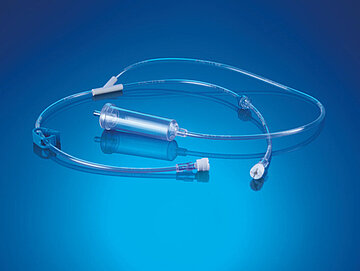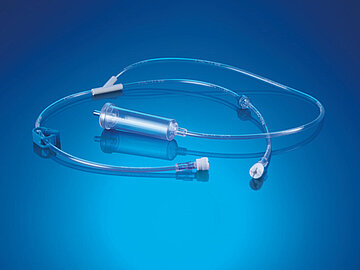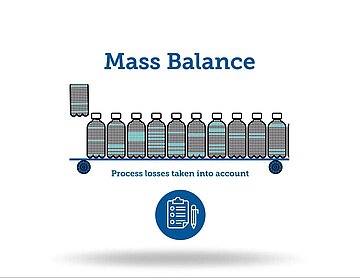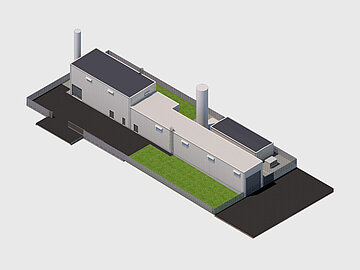
- Sustainability
- Interview
- Reading time: 6 min
Commitment to Sustainability - Certified Renewable Materials and Green Product Prototypes
Learn how RAUMEDIC is leading the future in reducing carbon footprints for medical and pharma technological applications - with ISCC PLUS materials and innovative biopolymers.
An interview with Jessica Pemp
Key points – briefly summarized:
- RAUMEDIC's ISCC PLUS certification ensures traceability of sustainable raw materials’ origin.
- Biopolymers, derived from renewable raw materials, are an environmentally friendly alternative to fossil-based polymers.
- Customers can switch to ISCC PLUS-certified materials and reduce their footprint in the upstream value chain - supported by a “Declaration of Equivalence”.
- RAUMEDIC goes beyond the use of sustainable materials, offering holistic footprint optimization advice to interested parties, considering factors like logistics and renewable energy.
- With a holistic approach to footprint optimization, RAUMEDIC is keen to deliver the best results for customers looking to reduce the footprint of their upstream values stream.
Hello Jessica! RAUMEDIC provides customers with ISCC PLUS certified materials. What is ISCC PLUS, and how can customers benefit from it?
ISCC PLUS stands for “International Sustainability and Carbon Certification PLUS”. It is a certification system designed to verify the sustainability of feedstocks that contribute to the circular economy and bioeconomy. It builds upon the established ISCC standard and allows companies to voluntarily demonstrate the sustainable origin of bio-based, bio-circular and circular raw materials.
To ensure the traceability of the sustainable raw materials used along the entire supply chain, each part of this chain must be certified by a third party. RAUMEDIC is proud to have received the ISCC PLUS certification in September 2023.
What are biopolymers?
Biopolymers (also known as bioplastics) are polymers that are obtained from renewable raw materials (e.g. living organisms such as plants) and are in some cases biodegradable.
They differ from conventional fossil polymers in the origin of the monomers used (the smallest building blocks of plastics). By using renewable raw materials as their source, biopolymers offer enormous CO2 saving potential. For this reason, the demand for and further development of biopolymers - also in the medical and pharmaceutical sector - has increased significantly in recent times. In general, we need to distinguish between two types of biopolymers: novel biopolymers and drop-in biopolymers.
Green product prototype by RAUMEDIC
All self-manufactured components made from fossil-based plastics were replaced by biopolymers.

What is the difference between drop-in biopolymers and novel biopolymers?
A drop-in biopolymer is a kind of copy of the conventional polymer. But it’s made from biomass instead of fossil oil. The drop-in bioplastics have the same chemical structure as their petrochemical counterparts and therefore the same properties and processing capabilities.
The advantage is that the converter (e.g. RAUMEDIC) can replace the fossil-based polymers by drop-in biopolymers while using the same machinery and equipment. The resulting product cannot be distinguished from the product made from fossil plastics.
Novel biopolymers, on the other hand, form new classes of plastics, some of them differing considerably from conventional plastics. Due to their new chemical structure, they have different and in some cases improved processing, utilization and disposal properties.
So what do biopolymers have to do with ISCC PLUS – where is the link?
ISCC PLUS is designed for all companies seeking to demonstrate the sustainable origin of their raw materials. The implications for (potential) customers of RAUMEDIC are clear: with the ISCC PLUS certification, raw materials can be traced seamlessly and transparently, ensuring confidence among customers that product solutions are truly sustainable as declared.
In addition, ISCC PLUS certification gives us access to a wide range of other drop-in biopolymers, especially those which are suitable for use in the medical and pharmaceutical sectors. This is because ISCC PLUS allows the use of the mass balance approach.
ISCC PLUS relies on the mass balance approach. What does this mean, and why is it crucial to understand this concept?
The mass balance principle can best be illustrated by comparing it to green energy: Consumers purchase “green” electricity generated from renewable sources. Yet, the electricity coming from their outlets is a "blended product" as all electricity, regardless of its origin, is fed into the grid.
Similarly, in the case of ISCC PLUS materials, renewable resources are mixed with fossil ones in existing systems. Both feedstocks used to produce the plastics are chemically identical. However, the mass balance approach allows tracking the quantity of sustainable resources in the value chain, allocating it through a verifiable accounting system.
The significant advantage: The resulting drop-in biopolymers are identical to their fossil counterparts. Applying the mass balance approach facilitates a seamless transition from fossil to renewable resources within existing systems.

Why is this system particularly interesting for us in the MedTech and PharmaTech industries?
The big advantage of this system is that the ISCC PLUS material we receive is identical to our "standard" material - it comes from the same production facility and retains all the quality standards of a Medical Grade Polymer.
The raw material supplier issues a "Declaration of Equivalence" - confirming that the "old" raw material is equivalent to the “new” ISCC PLUS certified material. The only difference is that an additional document is supplied for this material - the Sustainability Declaration. This verifies the sustainability of the material. We also create this kind of document for our products and provide it with every delivery to give our customers additional assurance.
To summarize: we receive a more sustainable material without having to compromise on quality and service.
What is the main benefit of ISCC PLUS certified materials for customers?
The potential to significantly lower the carbon footprint in their supply chain while maintaining the good properties and quality of the product. Particularly, certain product categories can experience a substantial reduction in CO2 emissions when ISCC PLUS certified materials are used.
Our thermoplastic (TPE) fluid processing tubing is a great example. With a simple switch, the carbon footprint of the material can be reduced by 81%.
If someone is interested in learning more about footprint-optimizing their supply chain for polymeric components for medical and pharmaceutical technology, how can RAUMEDIC help?
Our sustainability management will gladly advise interested parties on how to optimize the footprint of parts, components, or products that we seek to provide. We take a wholistic look and try to lower the environmental as much as feasible.
For this, we don’t just take a look at ISCC PLUS materials, but also logistics, renewable energy creation near our factories with our own energy center (under construction) – and much more!
Anyone who is interested can just contact us – and we’ll get back to you as soon as possible.
Biomass heating plant at RAUMEDIC’s headquarters
Producing renewable energy for the nearby factories.


About Jessica Pemp
Jessica Pemp, Materials Engineer at RAUMEDIC, specializes in biopolymers for medical and pharmaceutical applications. She advises industry stakeholders on facilitating a seamless transition towards sustainable choices in material selection.
Jessica is well-versed in addressing common queries on sustainable materials made of renewable or biobased feedstocks, elucidating the benefits of ISCC PLUS certification, and offering insights into holistic footprint optimization.